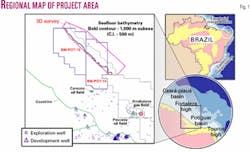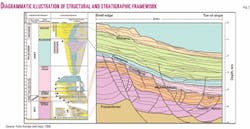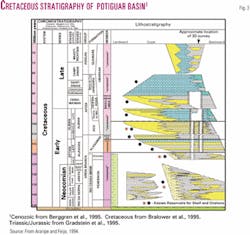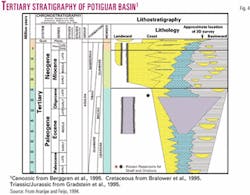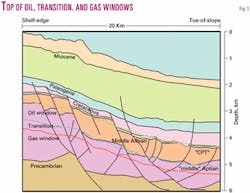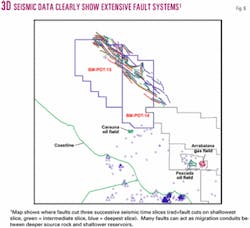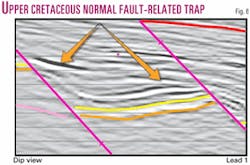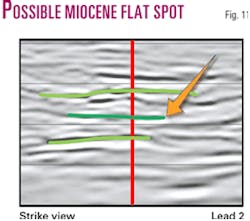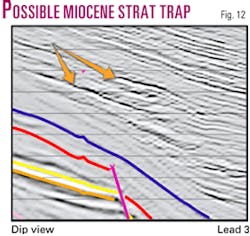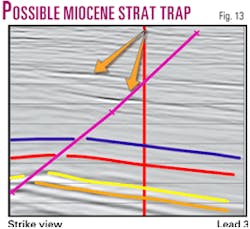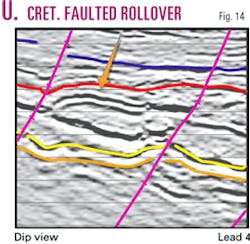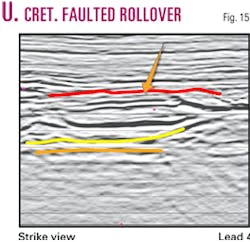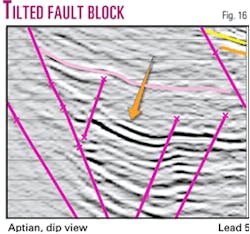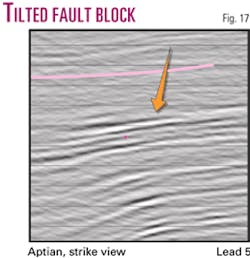The structural/stratigraphic evolution of the deepwater Potiguar basin off northeastern Brazil is complex but has resulted in an environment favorable for hydrocarbon accumulations.
Reservoir potential exists in sediments ranging from Early Cretaceous to Miocene, with reservoirs developed in lacustrine, fluviodeltaic, shallow marine, and deep marine turbidite depositional systems.
Burial history and thermal history are such that potential source rocks have passed into or through the oil window. The extensive fault systems extending from basin basement into Miocene strata provide conduits for hydrocarbon migration into younger reservoirs (allochthonous sourcing). Several play types that are productive in onshore and offshore fields are also present in the deepwater area.
The greatest potential for new discoveries is likely to be in extensive turbidite systems that have existed since the Cretaceous. Several leads were rapidly identified in the Aptian, Upper Cretaceous, and Miocene, suggesting that detailed analysis should yield more leads and/or drillable prospects.
Introduction
The Potiguar basin is the easternmost basin of the equatorial chain of continental margin basins of Brazil. It is located between the Ceará-Piauá
More than 4,000 wells have been drilled in the basin since 1973 when the first commercial field was discovered (offshore Ubarana field). Some 350 of these wells have been drilled offshore, resulting in 6 oil and gas field discoveries including Carauna, Pescada, and Arrabaiana (Fig. 1). Almost all offshore exploration to date has been limited to the continental platform area, and as a result, the continental slope and deep basin floor areas remain unexplored.
This article summarizes recent work that we conducted on the prospectivity of the deepwater part of the Potiguar basin. It is based upon analysis of a 1,850 sq km multiclient 3D survey acquired by PGS in 2000, as well as a variety of public domain data and publications, and internal reports. The elements that we focused on include:
- Stratigraphic and tectonic framework.
- Depositional systems and reservoir potential.
- Presence of hydrocarbon source, maturation level, and identification of migration pathways.
- Identification of preliminary leads.
Tectonic and stratigraphic framework
The Potiguar basin contains strata ranging in age from Early Cretaceous (Neocomian) to Recent (Fig. 2). The tectonic and stratigraphic framework of the Potiguar basin has been extensively studied and related to three major tectonic phases.1 2 3 These include an initial rift phase (Neocomian-Early Aptian), followed by a transitional phase (Middle Aptian-Early Albian), and finally, a drift phase (Early Albian-Recent).
The rift phase (Neocomian-Early Aptian) is the result of the breakup and separation of the present day South American and African continents. Structures observed include asymmetric grabens resulting from normal and antithetic faulting from a SW-NE-striking rift system.
The Pendencia and Pescada formations are the major lithologic units deposited during the tectonic rift phase (Fig. 3). Pendencia and Pescada depositional systems include complex lacustrine, alluvial fan, and fluviodeltaic deposits, which contain proven reservoir and source rock. During the Late Barremian the direction of extensional forces changed to a WNW-ESE-striking rift system, which overprints the older rift system in the central part of the offshore Potiguar basin.
The transitional phase (Middle Aptian-Early Albian) represents a time of subsidence and general tectonic quiescence, with faulting largely controlled by rift phase fault systems. The Alagamar formation comprises depositional systems ranging from complex fluviodeltaic to shallow marine, which contain proven reservoir and source rock. This stratigraphic interval differs from age equivalent units in other Brazilian eastern margin basins, where significant evaporite deposition took place. The Alagamar formation is subdivided into two members, the Upanema member and the Galinhos member. A distinctive pelitic layer named the Camadas Ponta Tubaráo (CPT), which is recognized as a regional seismic marker, separates these members. The CPT consists of an ostracodal carbonate packstone and black, euxinic shale deposited as a result of several initial marine incursions.4
The drift phase (Early Albian-Recent), like the preceding transitional phase, represents a period of subsidence and general tectonic quiescence, with faulting largely controlled by rift phase fault systems. Depositional systems range from complex fluviodeltaic and marine shelf to slope to basin (Figs. 3 and 4). Submarine canyon systems are present, containing flows of fine to coarse, turbiditic clastic debris. Post Campanian sediments are only found in the offshore part of Potiguar basin.
Six major surfaces were identified at the shelf-edge and correlated into the project area. Five surfaces are major unconformities and one (CPT), is a maximum flooding surface (Figs. 2, 3, and 4). The six surfaces, from oldest to youngest are:
- Top of middle Aptian (unconformity, approximately the top of the Pendencia/Pescada formations);
- Top of CPT (maximum flooding surface within Alagamar formation);
- Top of Middle Albian (unconformity within Acu formation);
- Top of Upper Cretaceous (unconformity within Ubarana formation);
- Top of Paleogene (unconformity within Ubarana formation); and
- Top of Miocene (unconformity within Ubarana formation).
Depositional systems and reservoir potential
Major depositional systems and sediments with reservoir potential are most easily understood in a tectonic context.
Rift phase depositional systems include nonmarine fan delta, alluvial plain, delta plain, and lacustrine delta front and prodelta. The Transitional phase depositional systems include mainly fluviodeltaic and marine carbonate shelf deposits.
Drift phase transgressional depositional systems include dominant carbonate deposition occurring on the shelf and shelf edge; and dominant pelagic deposition on the slope and basin with occasional down-cutting turbidite systems on the slope. Drift phase regressive depositional systems include dominant down-cutting turbidite systems, resulting in reworking of older shelf deposits within channels on the slope and in basin floor fan systems.
Table 1 describes the most common reservoir facies identified in onshore and offshore fields. They represent the most likely reservoir facies to occur within the study area. Porosity and permeability ranges are documented in several references of onshore and offshore fields.
Hydrocarbon source, maturation, and migration
The Pendencia and Alagamar formations contain the only proven source rocks in the Potiguar basin.
The Pendencia source rock is the principal hydrocarbon source in the basin and comprises thick beds of lacustrine, organic-rich, calcareous black shale with TOC values up to 6%.5 The Pendencia formation source rock is mature in most of the basin and is calculated to have entered the oil window between the Barremian (base) and the Late Paleocene (top). Currently, the top of the Pendencia is considered to be at peak oil maturity, while the base entered the gas window during Early Paleocene.6
The Alagamar source rock is the secondary source in the basin and comprises lacustrine anoxic shale and calcareous black shale and marl with TOC values up to 13%.7 The Alagamar source rock is calculated to have entered the oil window between the Campanian (base) and Late Oligocene (top) and has probably not yet reached peak oil maturity.6
Using the time-temperature and vitrinite reflectance (Ro) data for the 3-RNS-86 well from Pescada field8 and assuming an average geothermal gradient; top of oil, transition, and gas windows were inferred and projected into the study area (Fig. 5).
Hydrocarbons originating in the Pendencia and Alagamar source beds are found in traps of the same formation (autochthonous sourcing), as well as traps containing younger units. In both cases, faults act as the primary migration conduit. Some of these faults are easily mapped on 3D seismic data (Fig. 6).
Exploration play types and leads
Several play types have been recognized based on data from onshore and offshore fields.9 All of these play types could be present within the slope area, and a few have been observed in the study area (Fig. 7).
Trap types associated with rift sequence strata include:
- Drape structures located over rotated basement fault blocks;
- Structures caused by gravitational sliding along listric faults; and
- Structures controlled by antithetic faulting.
Trap types associated with transitional or post-rift sequence strata include:
- Wrench fault related traps;
- Faulted drape structures; and
- Stratigraphic traps resulting from truncation by shale-filled canyon.
Trap types associated with drift sequence strata include:
- Combination traps caused by facies variations and drape on hinge lines;
- Paleogeomorphic traps; and
- Shale-encased canyon-fill related turbidite flows.
Several leads were identified, and selected examples are shown in Figs. 8 to 17. Tops are identified as follows: Paleogene-dark blue; Cretaceous-red; Middle Albian-yellow; CPT-orange, and Middle Aptian-pink. Black arrows indicate migration pathways, and orange arrows indicate specific leads identified.
References
- Cremonini, O.A., et al., "O rifte Potiguar: Novos dados e implicaçöes tectönicas. 4o simpósio sobre o Cretáceo do Brasil," UNESP, Aguas de São Pedro, 1993, pp. 89-93.
- de Matos, R.M.D., "The northeast Brazilian rift system," Tectonics, Vol. 11, 1992, pp. 766-791.
- Ojeda, H.A.O., "Structural framework, stratigraphy and evolution of Brazilian marginal basins," AAPG Bull., Vol. 66, 1982, pp. 732-749.
- Lieberman, H.M., "Petroleum geology and field information overview of the Potiguar basin, Brazil," PGS Internal Report, 2000, 46 p.
- Trinidade, L.A.F., et al., "Petroleum migration and mixing in the Potiguar basin, Brazil," AAPG Bull., Vol. 76, No. 12, 1992, pp. 1903-24.
- Mello, U.T., "Evolução termonmecãnica da Bacia Potiguar-RN-Brasil," master's thesis, UFOP, Ouro Preto, 1987, 186 p.
- Mello, M.R., et al., "Geochemical and micropaleontological characterization of lacustrine and marine hypersaline environments from Brazilian sedimentary basins," in Katz, B.A., and Pratt, L.M., "Source rocks in a sequence stratigraphic framework," AAPG Studies in Geology, No. 37, 1993, pp. 17-34.
- de Souza, R.S., "Reservatórios profundos da formacão Pendência no campo de Pescada, Bacia de Potiguar: potencial e fatores controladores da porosidade," Bol. Geoc. Petrobrás, Vol. 4, No. 4, 1990, pp. 531-553.
- Bertani, R.T., et al., "Evolução tectono-sedimentar, estilo estrutural e habitat do petróleo na Bacia Potiguar," in Gabaglia, G.P.R., and Milani, E.J., "Origem e evolução de bacias sedimentares," Petrobrás/SDRH, Rio de Janeiro, 1990, pp. 291-310. Araripe, P.T., and Feijó, F.J., "Bacia Potiguar," Bol. Geoc. Petrobrás, Vol. 8, No. 1, 1994, pp. 127-141.
The authors
Robert Nail is a stratigrapher and petrophysicist for PGS Reservoir Consultants in Houston. He has directed and participated in several onshore and offshore geologic exploration and field evaluations worldwide, including Gulf of Mexico, Permian Basin, Brazil, Argentina, West Africa, North Sea, and China. He has a PhD and BS from Texas Tech University and an MS from The University of Texas at Arlington.
Rick Jackson is a geophysicist at PGS Reservoir Consultants. He has five years of experience gained at Hunt Oil Co. and PGS. He has been involved in regional studies in the Gulf of Mexico and off Brazil. He holds degrees from the University of Houston.
Anthony D'Agostino is manager of stratigraphic services for PGS Reservoir Consultants in Houston. He has 22 years of experience in technology support for ARCO, TD Geoscience, and PGS in domestic and international operations. He has degrees from Illinois State and Northern Illinois Universities.
Allen Bertagne ([email protected]) is vice president of geoscience at PGS Reservoir Consultants. He has more than 20 years experience gained at Exxon, AJB Exploration, CGG, and PGS. He has been involved in regional studies and field studies throughout the world. He holds degrees from Imperial College and UT Austin.
Mark Wilkinson, president of PGS Exploration NSA, has been in the industry for 18 years focused on North and South America. He holds a BS in geophysics from Texas A&M University.
Rick Roberson is business development geologist for PGS Exploration NSA. He has 10 years industry experience in North and South America and has a BS and MS in geology from Stephen F. Austin State University.
Luiz Neves is a partner of Gaia Corp. He has 20 years industry experience in Europe and North and South America and has a BS from Federal University of Rio de Janeiro and MS in marine geology from Tokyo University.
